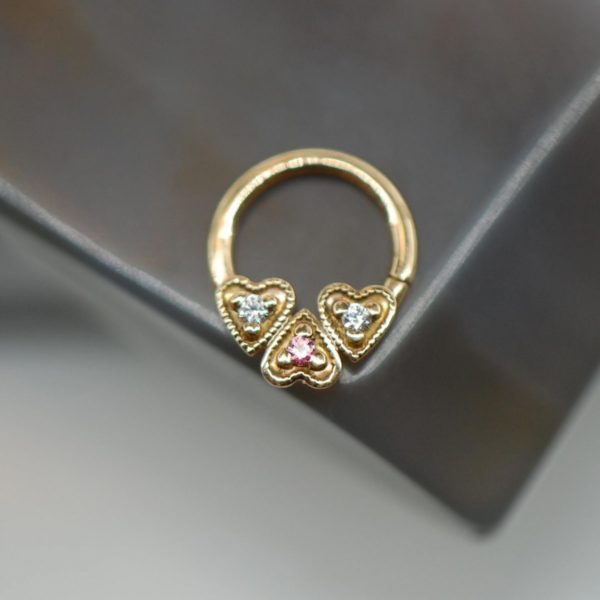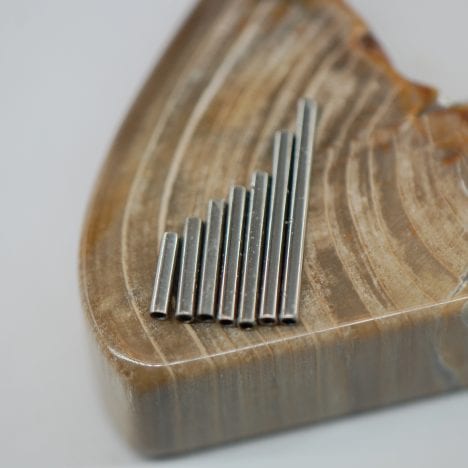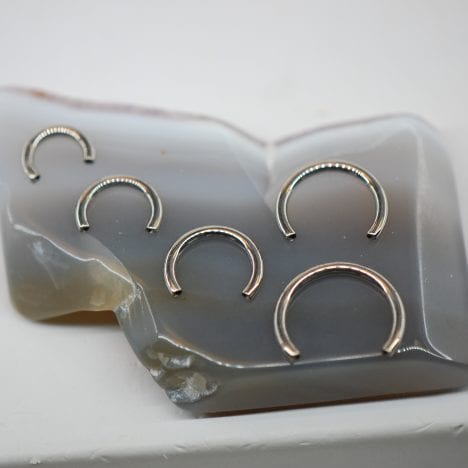Modern body piercing has reached a point where the jewelry selection has expanded to much more than just a simple silver bead or an overly bright acrylic dice. There are now an abundance of companies who make genuine stone and solid gold or platinum pieces exclusively for use in body piercing! After all, who doesn’t love the beautiful shine of a diamond, the play of color across an opal, or the glittering reflection of white gold? We are more excited than ever to be able to offer body jewelry with the same exquisite design and stone selection as is available from your local jeweler! We understand that just like a diamond pendant, your new genuine stone body jewelry is an investment that you’d like to preserve and enjoy for its entire lifespan; this means routine cleaning!
Body jewelry tends to be something we wear day in and day out and seldom remove. This daily wear means that over time, your pieces may start to dull from the collection of things like dead skin cells, shampoo, etc. If your piercing is still healing you should be gentle when cleaning your jewelry. If you aren’t wearing any prong set jewelry, you can use a disposable pointed makeup q-tip with some saline to gently clean around the piece. It’s not suggested to use things such as cotton balls or make up rounds because they can leave behind small cotton strands that may remain on the jewelry and collect further debris. While healing you are a little limited with what methods of cleaning you can use since you want to avoid anything that may irritate the piercing. We never suggest removing jewelry for cleaning because healing piercings should not be left empty.
Once your piercing is fully healed, it is much easier to keep your jewelry sparkling like new. Our favorite suggestion here at Amato is the water pik! Sometimes called a water flosser, these pressurized machines are typically used to clean your teeth; however, on a low setting you can safely use this to clean your jewelry! It can even be used while you are wearing the piece as long as the piercing is fully healed. The small jet of water is perfect for cleaning behind prongs and even better for getting into small delicate designs to clean them out. You should only ever use the low setting for jewelry, with warm clean water. The higher settings can be too rough on delicate pieces and run the risk of damaging jewelry. These water flossers usually come with interchangeable heads (like electric toothbrushes) so you can keep an extra head specifically to use for jewelry cleaning; be sure to separate this attachment from any you use for your teeth or mouth. If your jewelry is easy for you to remove on your own, waterpiking over a sink is easiest but PLEASE close or cover the drain! Your jewelry has a lifetime guarantee against everything but loss, so take precautions. Putting down a towel with a contrasting color to the piece can also help make sure if you drop it you can easily find it. Some piercings are tough to remove on your own, but with a gentle and cautious hand, you can waterpik it while you are wearing it. The waterpik can be a bit messy in general, but particularly for cleaning piercings you are still wearing, so we love using the cordless version in the shower! This way, who cares if you get water everywhere? With ear piercings make sure to cover your ear canal so you don’t accidentally spray astray. The same advice goes for nostril piercings and covering your nasal passages.
The Gemological Institute of America themselves actually now suggests waterpiks for cleaning jewelry, which is where we got the advice. Previously, chemical cleaners were suggested but it was easy to accidentally damage your jewelry by using the wrong product on the wrong gems or metals. These cleaners are often very harsh and can crack opals, discolor pearls, or shatter emeralds if they are used incorrectly even on regular jewelry.
Although many of our companies work with the same materials that are used in standard finger rings and bracelets, it’s important to note that body jewelry should never be cleaned with any gold and/or silver jewelry cleaner found on the market. Since these pieces are worn IN the body and not just ON the body. If any of those cleaners remained on the jewelry when it was re-inserted, they may irritated even a well healed piercing. Things like peroxide and alcohol should also never be used for jewelry cleaning. Again, these products can be harmful to your piercings, and have the risk of damaging your jewelry. Titanium in particular (which is what we use a lot of here at Amato and what many reputable studios often use) can be dramatically damaged by peroxide so it’s safest to avoid using it.
Prong set pieces are likely to require more frequent cleanings than bezel set pieces, as prong settings are open and allow debris to collect behind the stones; whereas a bezel typically only has debris build up around the setting that is easily wiped away . Likewise, crown set pieces are a middle ground that will also need a little more TLC. Open style settings, particularly when worn in areas that regularly come in contact with makeup, soaps, or cream products, can get dirty faster than others. If you haven’t gotten around to purchasing a waterpik, or maybe it’s just out of budget right now, then we love the trick of using micellar water to clean out a piece clogged with makeup or other similar products. Micellar water (when it’s additive free) is essentially just water packed with lots of micelle molecules. These dirt and debris loving molecules attach to makeup to break it down and clean it away gently. With no harsh chemicals, this cleaner has long been popular overseas and has recently made its way stateside. While we adore this as a makeup remover it also works exceptionally well soaked on some gauze and held up around dirty jewelry to help melt away stubborn skin products that have gunked up your lovely gems.
All of this cleaning will be for naught if your jewelry isn’t stored correctly! Please make sure to keep your pieces separate so that your prongs and posts don’t scratch one another. For example, keeping a titanium prong set gem in the same bag or box with a genuine opal is a bad idea; that hard titanium prong can easily bounce around and even scratch your lovely (but soft) opal. For this reason we always suggest keeping pieces in separate, sealed sections or bags so they can’t scratch each other, or at the very least separating your gold and genuine pieces from your harder titanium ends. Gold is relatively soft and can be nicked easily so it’s always important to store your pieces thoughtfully to prevent damage. Make sure threadless ends are stored either assembled in a barbell, or in a box or container that will prevent them from getting smushed- those little pins are delicate and easy to break and bend and storing them properly will keep them safe for a life time!





